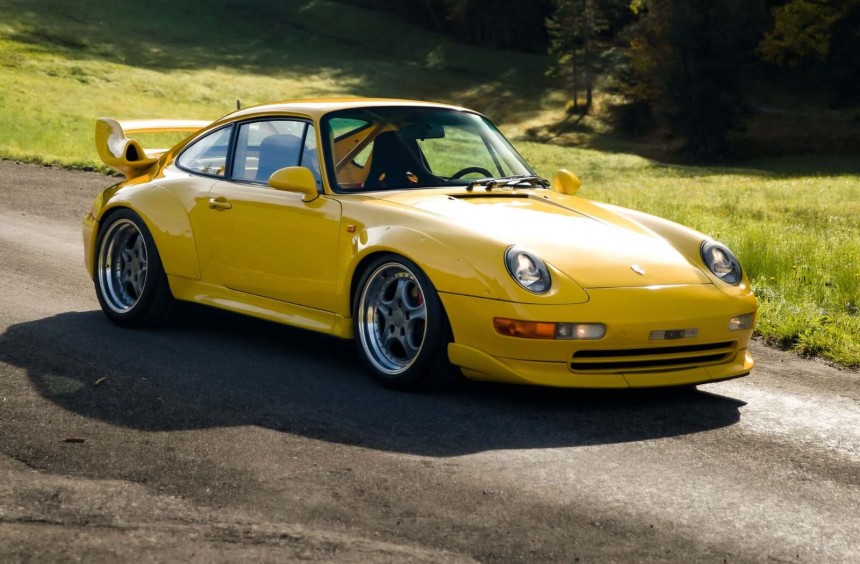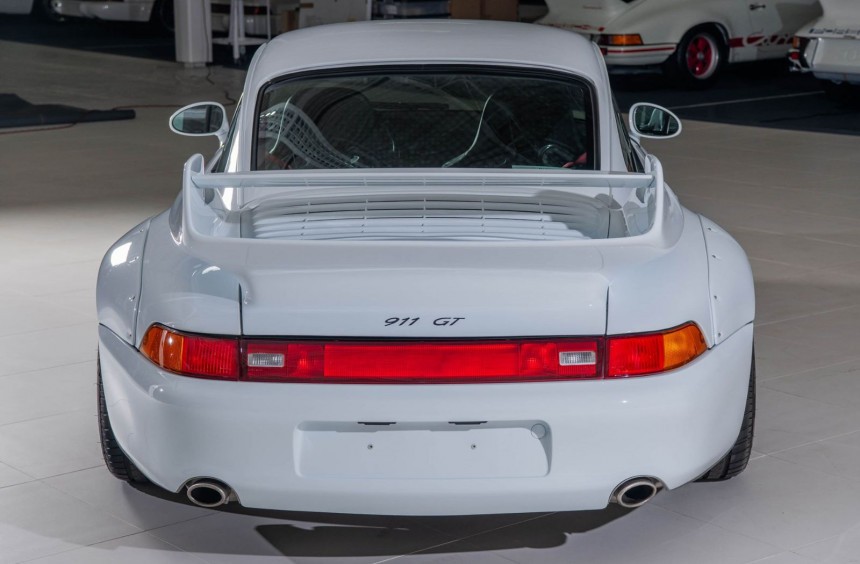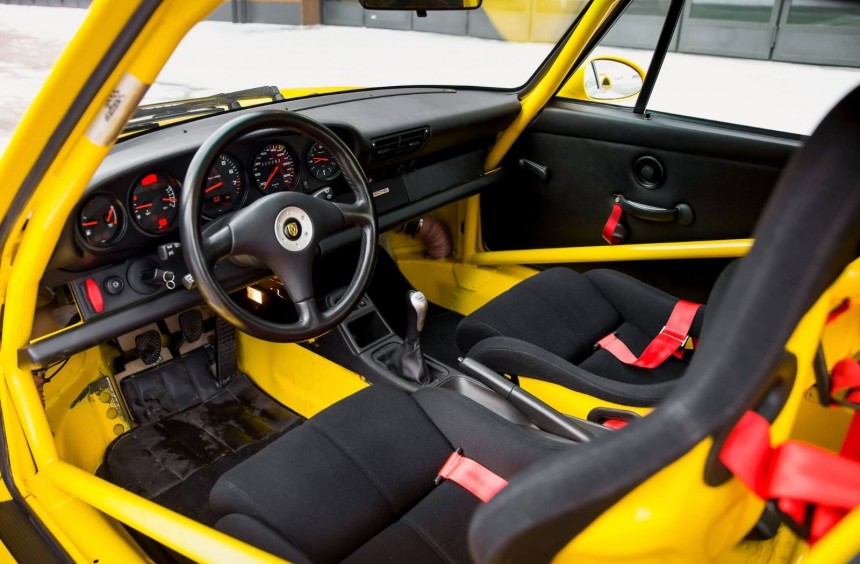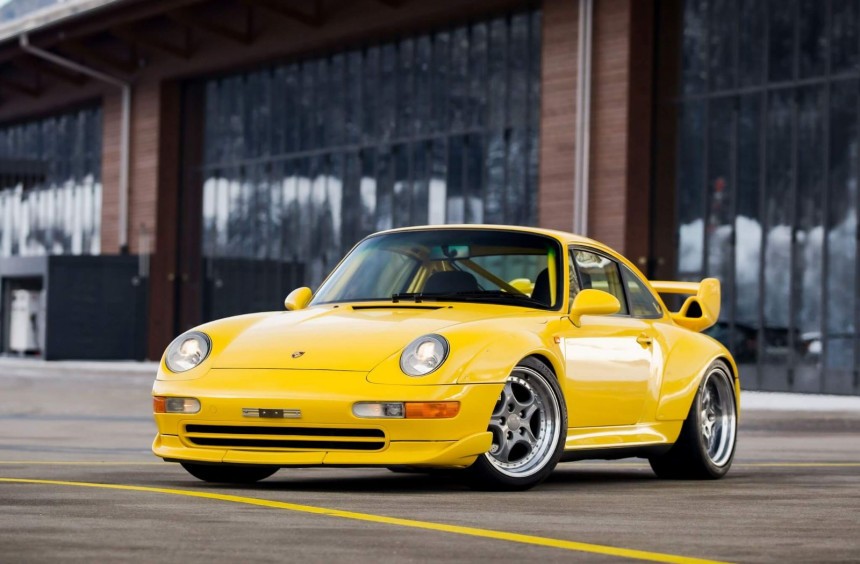Collectively (and unofficially) dubbed the first GT2, the 993-generation 911 GT was the road-legal, air-cooled Porsche that came closest to perfection - even though it was developed with a small budget on hand.
During the first part of the 1990s, Porsche - like many other sports car-focused carmakers - was running out of funds at an accelerated pace.
With sales dropping from around 50,000 units in 1986 to well under 14,000 in 1993, the German manufacturer was desperate to stop the slide.
One of the solutions it came up with was supplementing its customer racing program by adding the 964-based 911 3.8 Carrera RSR and the 968 Turbo RS in 1993.
Another solution was refreshing the 911 lineup with the all-new 993 generation that hit the streets in January 1994.
About a year later, the customer racing program received another new member: the 993 911 Turbo-based GT. Initially, it competed in the GT3 category, but starting with 1996, it moved up to the GT2 ranks - hence the GT2 moniker.
Porsche unveiled the racing version of the new 911 GT at the Essen Motor Show in November 1994. But, to make the project viable, they needed to homologate the car with a limited run of road-going versions.
Unlike modern times, when the development process of each new 911 GT3 race car and corresponding street version benefits from a huge budget, Porsche had to minimize production costs back then by getting creative.
With no funds to drastically reshape the 993 body, designers had to go for cost-saving measures usually employed by small tuner shops and/or amateur racing teams.
Therefore, the team cut out the wheel arches of a standard 911 Turbo body and then bolted large fiberglass extensions onto them. Furthermore, the chin spoiler from the Carrera RS was grafted to the stock front bumper to improve aerodynamics.
The only bespoke additions to the exterior were a set of larger Speedline wheels, fiberglass side skirts, and a twin-plane rear spoiler with integrated air ducts.
Though not extensive, these cost-effective visual upgrades were just what the 993 Tubro needed to improve aerodynamics and transform it into the most beautiful air-cooled Porsche ever created.
To keep production costs at a minimum, the development of the 911 GT's chassis focused on using existing components and shedding unnecessary weight.
The suspension setup was borrowed from the newly introduced 993 Carrera RS, receiving only adjustable anti-roll bars and shocks, as well as beefier springs, track rods, and link bearings.
The braking system with 322-mm cross-drilled rotors and four-piston calipers of the stock 911 Turbo was deemed good enough for the GT, so it was carried over without modifications.
The same went with the steering system, albeit the ratio was slightly modified for a more direct feel.
Furthermore, to meet homologation requirements and save weight, the 911 Turbo's standard all-wheel-drive system was dropped in favor of a good ol' rear-wheel drivetrain.
Powering the rear wheels was nothing more than the 911 Turbo's Type M64/60 3.6-liter flat-six mated to the stock six-speed manual.
Again, engineers fought to make something out of nothing by improving output with the slightest bit of tuning.
The tunning only included a remap of the Bosch Motronic ECU, the addition of free-flowing catalytic converters, and an increase of boost pressure from 11.6 psi (0.8 bar) to 13.05 (0.9 bar) for the KKK twin turbos.
Moreover, an oil cooler was added to the nose of the car, and the standard fuel tank was replaced with a higher-capacity unit.
When it was all said and done, the horsepower figures for the road-legal 911 GT's tuned flat-six went up from 408 hp (of the stock 911 Turbo) to 430 hp.
That wasn't a huge gain, but thanks to the removal of the 4WD system as well as anything else deemed unnecessary - like AC, power windows and mirror motors, rear bench, or the addition of thinner windows, the new 911 GT was a different kind of monster.
Nearly 660 pounds (300 kg) lighter than the standard 911 Turbo, the GT was capable of supercar-worthy performance, sprinting from 0 to 60 mph (97 kph) in 3.9 seconds and attaining a top speed of 187 mph (301 kph).
Apart from the full-race spec version, customers who wanted a 911 GT that could be legally driven on public roads could go for either the Comfort or Clubsport trims.
As the name implies, the first trim aimed to make the GT more comfortable. On the outside, nothing was changed, but inside, it featured carpeting and a pair of leather-trimmed Recaro buckets with conventional seatbelts.
Furthermore, customers could opt for reinstalling amenities like an air conditioning system, stereo, power windows, or even the Turbo's standard, airbag-equipped steering wheel.
On the other hand, the Club Sport edition was as close to the racing version as legally possible.
That meant no carpeting, no optional amenities, and the addition of motorsport hardware such as Recaro buckets wrapped in fire-retardant fabric, six-point harnesses, a battery cut-off switch, a fire extinguisher, and a full roll cage.
The 911 GT wasn't a resounding success that helped turn things around for Porsche. The savior came in the form of the 986 Boxter launched in 1996.
But, with low manufacturing costs (compared to a standard 911 Turbo) and a starting price of 268,000 Deutschmarks (around $752,000 in today's money), the GT helped bring in some much-needed funds.
The German manufacturer never released the official production figures of the 911 GT, but it's estimated that about 200 to 300 units (including around 70 race cars) were built.
Today, it's one of the most sought-after road-legal models ever released by the Zuffenhausen-based carmaker.
According to classic.com, the average value for a Comfort-spec GT currently stands at $780,000. The rarer Clubsport edition (only around 30 were built) is even more expensive, often demanding over $1.5 million when going under the hammer.
Bordering perfection, the greatest air-cooled Porsche - or, as some would say, the greatest Porsche of all time - paved the way for future twin-turbo 911 monsters marketed under the GT2 badge.
For more on this German legend, we recommend watching the YouTube video below by Carfection.
With sales dropping from around 50,000 units in 1986 to well under 14,000 in 1993, the German manufacturer was desperate to stop the slide.
One of the solutions it came up with was supplementing its customer racing program by adding the 964-based 911 3.8 Carrera RSR and the 968 Turbo RS in 1993.
Another solution was refreshing the 911 lineup with the all-new 993 generation that hit the streets in January 1994.
About a year later, the customer racing program received another new member: the 993 911 Turbo-based GT. Initially, it competed in the GT3 category, but starting with 1996, it moved up to the GT2 ranks - hence the GT2 moniker.
Developing the most beautiful air-cooler 911 on a tight budget
Unlike modern times, when the development process of each new 911 GT3 race car and corresponding street version benefits from a huge budget, Porsche had to minimize production costs back then by getting creative.
With no funds to drastically reshape the 993 body, designers had to go for cost-saving measures usually employed by small tuner shops and/or amateur racing teams.
Therefore, the team cut out the wheel arches of a standard 911 Turbo body and then bolted large fiberglass extensions onto them. Furthermore, the chin spoiler from the Carrera RS was grafted to the stock front bumper to improve aerodynamics.
The only bespoke additions to the exterior were a set of larger Speedline wheels, fiberglass side skirts, and a twin-plane rear spoiler with integrated air ducts.
Though not extensive, these cost-effective visual upgrades were just what the 993 Tubro needed to improve aerodynamics and transform it into the most beautiful air-cooled Porsche ever created.
Using the same formula to improve the chassis
The suspension setup was borrowed from the newly introduced 993 Carrera RS, receiving only adjustable anti-roll bars and shocks, as well as beefier springs, track rods, and link bearings.
The braking system with 322-mm cross-drilled rotors and four-piston calipers of the stock 911 Turbo was deemed good enough for the GT, so it was carried over without modifications.
The same went with the steering system, albeit the ratio was slightly modified for a more direct feel.
Furthermore, to meet homologation requirements and save weight, the 911 Turbo's standard all-wheel-drive system was dropped in favor of a good ol' rear-wheel drivetrain.
Subtle engine tuning and weight-saving galore
Again, engineers fought to make something out of nothing by improving output with the slightest bit of tuning.
The tunning only included a remap of the Bosch Motronic ECU, the addition of free-flowing catalytic converters, and an increase of boost pressure from 11.6 psi (0.8 bar) to 13.05 (0.9 bar) for the KKK twin turbos.
Moreover, an oil cooler was added to the nose of the car, and the standard fuel tank was replaced with a higher-capacity unit.
When it was all said and done, the horsepower figures for the road-legal 911 GT's tuned flat-six went up from 408 hp (of the stock 911 Turbo) to 430 hp.
That wasn't a huge gain, but thanks to the removal of the 4WD system as well as anything else deemed unnecessary - like AC, power windows and mirror motors, rear bench, or the addition of thinner windows, the new 911 GT was a different kind of monster.
Nearly 660 pounds (300 kg) lighter than the standard 911 Turbo, the GT was capable of supercar-worthy performance, sprinting from 0 to 60 mph (97 kph) in 3.9 seconds and attaining a top speed of 187 mph (301 kph).
Two options to choose from
As the name implies, the first trim aimed to make the GT more comfortable. On the outside, nothing was changed, but inside, it featured carpeting and a pair of leather-trimmed Recaro buckets with conventional seatbelts.
Furthermore, customers could opt for reinstalling amenities like an air conditioning system, stereo, power windows, or even the Turbo's standard, airbag-equipped steering wheel.
On the other hand, the Club Sport edition was as close to the racing version as legally possible.
That meant no carpeting, no optional amenities, and the addition of motorsport hardware such as Recaro buckets wrapped in fire-retardant fabric, six-point harnesses, a battery cut-off switch, a fire extinguisher, and a full roll cage.
One of the rarest, most sought-after street-legal Porsche
But, with low manufacturing costs (compared to a standard 911 Turbo) and a starting price of 268,000 Deutschmarks (around $752,000 in today's money), the GT helped bring in some much-needed funds.
The German manufacturer never released the official production figures of the 911 GT, but it's estimated that about 200 to 300 units (including around 70 race cars) were built.
Today, it's one of the most sought-after road-legal models ever released by the Zuffenhausen-based carmaker.
According to classic.com, the average value for a Comfort-spec GT currently stands at $780,000. The rarer Clubsport edition (only around 30 were built) is even more expensive, often demanding over $1.5 million when going under the hammer.
Bordering perfection, the greatest air-cooled Porsche - or, as some would say, the greatest Porsche of all time - paved the way for future twin-turbo 911 monsters marketed under the GT2 badge.
For more on this German legend, we recommend watching the YouTube video below by Carfection.





























